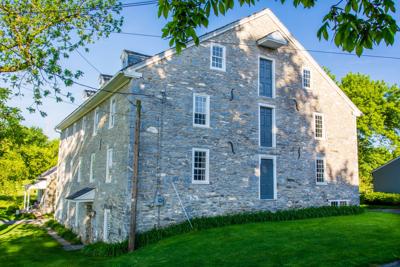There is something magical about old mills.
Donald Kautz has captured much of that magic, in words and especially in vivid color photos, in his new book on “The Mills of Lancaster County’’ (Masthof Press). The 372-page book traces the ownership of these mills through the years and tells stories associated with them.
Take Windom Mill, one of the most picturesque properties in Lancaster County.
The mill, and the complex of stone buildings that surrounds it, stands along Route 999 almost halfway between Millersville and Washington Boro in Manor Township. Besides the 1810 mill, there’s a 1780 farmhouse, a bank barn, a miller’s house, a tavern and several other buildings.
The farm, called Windom Mill, was patented in 1719 and listed on the National Register of Historic Places in 1994. Ken and Carolyn Rohrer, the current owners, gave the Scribbler a tour of the place a decade ago.
One story the Rohrers did not tell at that time was that, besides milling wheat and corn, the mill in the late 19th and early 20th centuries produced cider by pressing apples. Kautz relates that a group of boys arrived at school a bit tipsy one morning after stopping by the mill and drinking fermented cider.
Kautz says Windom is one of fewer than 100 mills still standing in the county. He describes and photographs each mill and then lists them in several different ways for easy reference. Compared with “The Conestoga River,’’ a slim book he published two years ago, this is a major project.
The first recorded mill in what would become Lancaster County was built on Mill Creek by Christopher Schlegel about 1714. Schlegel’s purchase of the land did not hold up. The Quaker Edmund Cartlidge purchased the property three years later, ejected Schlegel and built his own mill there.
Kautz says Cartlidge’s mill was sited where Goff Road comes closest to Mill Creek. That is about two miles south of Lancaster and northeast of Willow Street, near where one of this area’s sweetest spots, Evan’s Candy, is located today.
Mill Creek, a tributary of the Conestoga River, hosted many later mills. The Scribbler is fondly familiar with two of them.
What Kautz refers to as Smoketown Mill and which the Scribbler grew up calling Nolt’s Mill, actually was originally Gibbon’s Mill along the Old Philadelphia Pike between Smoketown and Bird-in-Hand. It is known for, among other things, its misspelled date stone that says it was “Biult by James Gibbons & Deborah in the year 1770.’’
Jim Nolt operated the mill from 1982 until 2004. A later owner sold the property to East Lampeter Township in 2020.
Another extraordinary Mill Stream mill is the Mascot Roller Mill, which anyone within roller-skating distance has usually called by the name of its last owner, Ressler’s Mill.
W. Franklin Ressler was a true character who, at a certain point, stopped changing anything in the mill, including the mill office/former post office where he read the Wall Street Journal every day. Today the Ressler Mill Foundation operates the mill and the Ressler home as a museum.
Readers will enjoy learning more about their favorite mills in this comprehensive and colorful book. And if you know something more about local mills, you can contact Kautz at donaldkautz.com. He has a website — millsoflancastercounty.com — where he will update information in the book.
Jack Brubaker, retired from the LNP staff, writes “The Scribbler’’ column every Sunday. He welcomes comments and contributions at scribblerlnp@gmail.com.




